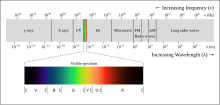Infrared spectroscopy

Infrared spectroscopy (sometimes called Infrared spectrometry) is a physical analysis method that uses infrared light. Typically, infrared spectroscopy uses a wavelength between 800nm and 1mm. The method can be used for quantitative analyses of known substances, or of the structural properties of unknown substances. Raman spectroscopy is another method that produces similar results. The main method used in infrared spectroscopy today is Fourier transform infrared spectroscopy, which uses Fourier transforms.
Infrared vibrational spectroscopy can be used to identify molecules by listing their chemical bonds. An IR spectrometer is a machine that shines infrared light from a set range of frequencies on a sample. It measures which exact light frequencies are absorbed by the sample.
Chemical bonds in a molecule make molecular vibrations at frequencies that are characteristic of the bonds. A group of atoms in a molecule may have multiple modes of oscillation caused by the stretching and bending motions of the group as a whole. If an oscillation leads to a change in dipole in the molecule, then it will absorb a photon which has the same frequency. The vibrational frequencies of most molecules correspond to the frequencies of infrared light. Typically, the technique is used to study organic compounds using light radiation from 4000–400 cm−1, the mid-infrared. The spectrometer records all the frequencies of absorption in a sample. This can be used to gain information about the sample composition in terms of chemical groups present and also its purity (for example a wet sample will show a broad O-H absorption around 3200 cm−1).
